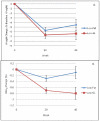Targeting dietary fat or glycemic load in the treatment of obesity and type 2 diabetes: a randomized controlled trial
- PMID: 21208675
- PMCID: PMC3079199
- DOI: 10.1016/j.diabres.2010.12.016
Targeting dietary fat or glycemic load in the treatment of obesity and type 2 diabetes: a randomized controlled trial
Abstract
Aims: To compare the effects of lifestyle modification programs that prescribe low-glycemic load (GL) vs. low-fat diets in a randomized trial.
Methods: Seventy-nine obese adults with type 2 diabetes received low-fat or low-GL dietary instruction, delivered in 40-week lifestyle modification programs with identical goals for calorie intake and physical activity. Changes in weight, HbA(1c), and other metabolic parameters were compared at weeks 20 and 40.
Results: Weight loss did not differ between groups at week 20 (low-fat: -5.7±3.7%; low-GL: -6.7±4.4%, p=.26) or week 40 (low-fat: -4.5±7.5%; low-GL: -6.4±8.2%, p=.28). Adjusting for changes in antidiabetic medications, subjects on the low-GL diet had larger reductions in HbA(1c) than those on the low-fat diet at week 20 (low-fat: -0.3±0.6%; low-GL: -0.7±0.6%, p=.01), and week 40 (low-fat: -0.1±1.2%; low-GL: -0.8±1.3%; p=.01). Groups did not differ significantly on any other metabolic outcomes (p≥.06).
Conclusions: Results suggest that targeting GL, rather than dietary fat, in a low-calorie diet can significantly enhance the effect of weight loss on HbA(1c) in patients with type 2 diabetes.
Copyright © 2010 Elsevier Ireland Ltd. All rights reserved.
Figures



References
-
- National Heart Lung and Blood Institute, North American Association for the Study of Obesity . The Practical Guide: Identification, Evaluation, and Treatment of Overweight and Obesity in Adults. National Institutes of Health; Bethesda: 2000.
-
- Anderson JW, Kendall CWC, Jenkins DJA. Importance of weight management in type 2 diabetes: review with meta-analysis of clinical studies. J Am Coll Nutr. 2003;22:331–339. - PubMed
-
- Ludwig DS, Majzoub JA, Al-Zahrani A, Dallal GE, Blanco I, Roberts SB. High glycemic index foods, overeating, and obesity. Pediatrics. 1999;103:e26. - PubMed
-
- Warren JM, Henry JK, Simonite V. Low glycemic index breakfasts and reduced food intake in preadolescent children. Pediatrics. 2003;112:e414. - PubMed
Publication types
MeSH terms
Substances
Grants and funding
LinkOut - more resources
Full Text Sources
Medical
Miscellaneous

